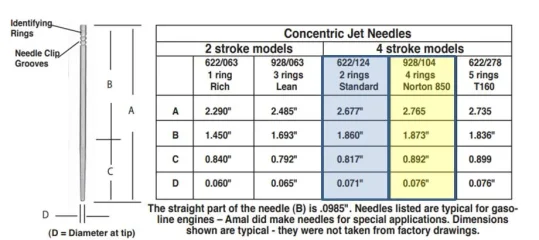I've just got back from a blast on the bike after fitting hard-anodised size 3 slides, instead of size 3½s, and it's transformed – no flat spot, no popping on the overrun, joyful out on the road, and perfectly happy in town! Halleluia – deep breath, and relax ...!
I'm extremely grateful for all the help and support in the course of this thread, without which I'm not sure I'd have got where I am now. But d'you know, I don't think I've ever encountered any clear advice on how to set up the carbs on an 850 if it left the factory with the black, plastic air box and bean-can silencers, but now has the same air box and peashooters. From today's developments, I wonder if I've finally cracked it! Thing is, I've learned to be wary of Andover Norton's online shop's part identifications over the years, but lately I have noticed improvements. So, when I noticed the other day that 3½ slides are qualified there as being for the MK2A, but otherwise are listed alongside size 3s for 850s, a penny dropped – barring the black plastic air box, my bike's no longer set up like a MK2A! The size 3 slide listed there must therefore be for 850s with 260 main jets (and 4-ring needles), which I now have! Sherlock Holmes would probably be shaking his head in despair ... As indeed some of you might be. Anyway, this sums up what I've done:
1. Make sure the plastic air box does not have the rubber venturi over the main intakes – remove them if present – and clean or replace the air filter, remembering to oil it, it doesn't take much.
2. Replace the 230 main jets with 260s.
3. Fit new, standard, .106 needle jets – they will be worn – and, if in doubt, new 4-ring needles – they last much longer because they are fairly free to rotate, and so wear more slowly.
4. Replace the size 3½ throttle slides with size 3s.
5. Clean the pilot bushes with a 0.016" or 0.4mm probe.
6. Balance the carbs.
And away you go!
Phew ... And I've only had the bike nearly 20 years! If it all goes pear-shaped I'll let you know, but for now it feels like a new bike ... One other thing – since fitting the first pair of hard-anodised slides, direct replacements at size 3½, fuel consumption has improved: it's gone from the mid-to-high 40s mpg to between 53 and 55 mpg. The size 3 slides are of course richer, so we'll see. The only other variable is that I have unbalanced downpipes, whereas the bike would've had balanced ones from new. I ought also to give an honourable mention here to Bushman's page on these carbs, it doesn't give the full picture but is a very handy, practical guide –
https://www.ntnoa.org/pdf/Bushmans Carb Tuning Secrets.pdf
About the StayUp floats, I returned mine to Burlen and the word is that, when tested, they seemed to be too
low! A reeeally helpful chap suggested I send him a pair of float bowls that he would then set up for me, so I should just be able to fit them and go when I get them back. I've sent them, and await a minor miracle! Cheers!


